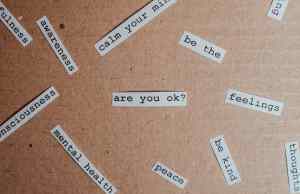While people experiencing active suicidal ideation usually have the intent, plan, or means to harm themselves, people experiencing passive suicidal ideation usually have thoughts of suicide but without the intent to follow through.
While passive suicidal thoughts may sound less severe than active ones, they are undoubtedly upsetting. It’s also important to note that passive and active suicidal ideation are not static — passive suicidal ideation can shift to more active thoughts of death, just as active suicidal ideation can recede to passive suicidal ideation.
It’s crucial that those experiencing any thoughts of suicide reach out for immediate help by calling 988, Suicide and Crisis Lifeline, or going to their nearest ER.
Signs and Symptoms of Passive Suicidal Ideation
Passive suicidal ideation is characterized by thoughts of one’s own death. This can include both direct and indirect ideation.
Direct thoughts often involve an explicit reference to or image of death. For example, statements like, “I wish I was dead,” or, “I hope I crash my car,” are direct thoughts. Indirect thoughts, on the other hand, only imply death — these can include thoughts like, “I can’t do this anymore,” or, “Why am I still here?”
Since suicidal ideation originate in one’s head, it can be hard to tell when someone else is experiencing them. However, there are several signs that might suggest someone is suicidal:
- Questioning one’s purpose
- Expressing hopelessness
- Talking about dying, either seriously or jokingly
- Talking about what it would be like if they were gone
- Engaging in risky behaviors
- Isolating oneself
- Disposing of/giving away their belongings
If someone you know is exhibiting any of these signs, reach out to them and see how they’re doing. Letting them know that you appreciate them and want them around can have a large effect on their mindset. Let them know that you’re willing to offer whatever support they need, and offer to help them find treatment.
Risk Factors and Triggers
Unsurprisingly, people often experience passive and active suicidal ideation if they are unhappy with their lives. This can be a result of a variety of events or causes. Some conditions that can trigger suicidal ideation include:
- Mental health issues, like depression, anxiety, or schizophrenia
- Barriers to mental health treatment
- Lack of adequate coping skills
- Lack of social support
- Feelings of hopelessness
- Chronic illness or pain
- Stressful or traumatic life events
Coping Strategies for Passive Suicidal Ideation
There are a variety of coping mechanisms that can help alleviate suicidal ideation. These include:
- Engaging in activities that make you feel better. Investing time in hobbies, skills, or time with friends can help make life seem worth living.
- Acknowledging the positive parts of your life. While this may not completely eliminate passive suicidal ideation, it can certainly help keep them at bay.
- Identifying a safe person or space. Being able to voice your feelings to someone without judgment can make a significant difference in your mood.
- Establishing a daily routine. Adding some structure to your daily life can restore a sense of purpose, which tends to reduce thoughts of suicide.
- Acknowledging triggers or stressors. Making note of what prompts suicidal ideation can often minimize their impact.
While these strategies can help you cope with suicidal ideation, seeking professional help is the best way to address passive suicidal thoughts. A therapist can not only offer you a space to express your feelings but can also equip you with a variety of coping techniques tailored to your specific needs.
Some effective treatment options for passive suicidal ideation include:
- Cognitive behavioral therapy (CBT). This popular form of therapy includes a variety of strategies to identify and replace negative thought patterns, including passive suicidal ideation.
- Dialectical behavioral therapy (DBT). A form of CBT, DBT focuses more closely on processing emotions, rather than thoughts or actions.
- Transcranial magnetic stimulation (TMS). This treatment involves sending powerful magnetic fields to areas of the brain related to depression. This treatment is often only considered when other first-line forms of treatment have been exhausted.
- Psychiatric medication. There are certain mental health disorders that can come with symptoms of suicidal thoughts and feelings, which can be treated effectively by a psychiatric professional with medication. For example, severe depressive disorders with antidepressants.
It’s important to reach out for help if you’re experiencing thoughts of suicide, even if they’re passive. Not only are they unpleasant, but they can also lead to more active thoughts or even self-harm if left untreated.
Professional Support at Thriveworks
Any thoughts of suicide, both passive and active, can make you feel trapped, alone, and isolated. Luckily, you don’t have to deal with them alone. A licensed therapist can give you the tools to cope with thoughts of suicide, and can even help you dispel them in the future.
At Thriveworks, we have hundreds of therapists and counselors who are well-equipped to assist you if you’re struggling with passive suicidal ideation. They specialize in a variety of issues and utilize a multitude of therapeutic techniques to create a treatment plan tailored to your needs. Find a therapist and schedule an appointment with us today.
If you’re experiencing active suicidal thoughts, please get immediate help by contacting the Suicide and Crisis Lifeline at 988 or going to your nearest ER.













